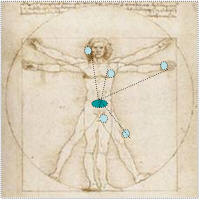7 things you should know about Body Area Networks (BANs)


For instance, small flat sensors placed on the skin, or even under it, could be used to create a "medical" body area network that provides doctors with real-time data about their patients' bio-signs. Another key application is short-range person-to-person communications that could help protect front line soldiers in combat.
BAN technology is still in its infancy and mainstream adoption is still over the horizon as engineers and researchers work to overcome challenges involving interoperability, sensor design constraints (i.e. power and complexity), privacy, and security to name a few. Once these issues are overcome, expect BANs to first revolutionize healthcare allowing for concepts like telemedicine and mHealth to become real, and potentially allow for groundbreaking uses in communications, security, and sports.
Below, in no particular order, is a list of facts, news, and generally good things to know about BANs:
IEEE 802.15 Task Group 6 is on the case
Established 2 years ago, the IEEE BAN task group is "developing a communication standard optimized for low power devices and operation, in or around the human body (but not limited to the human body) to serve a variety of applications..."
Primitive technologies spell an alphabet soup of overlapping acronyms
- MBANs - Medical Body Area Networks
- BSN -Body Sensor Network
- PAN- Personal Area Network or (WPAN for wireless)
- MANET - Mobile ad hoc network
- MICS - Medical Implant Communication Service
UK researchers are working with the military to develop multimedia-enabled helmet technology
Queen's University Belfast's Centre for Secure Information Technologies (CSIT) is working on equipment using advanced wireless systems that would outfit small squads of soldiers with head-up displays that share real-time video, covert surveillance data, and tactical info with each other. This would allow them to virtually think and act as a unified whole by providing high levels of situational awareness in hostile environments. According to a report, it can also be used to help preserve the element of surprise in close encounters with an enemy.
A wireless digital 'plaster' that monitors vital signs is being tested on patients and volunteers at Imperial College London
News.com reports of a company, Toumaz Technology, that has begun clinical trials of a disposable body worn monitoring device it has developed that allows for the monitoring of body temperature, heart rate, and respiration of patients in a continuous and remote (limited to within a hospital) fashion. Initial trial results are expected by the end of 2009 and if successful, could be a big step forward for Medical Body Area Networks.
mHealth Initiative sets new course with updated website and international event
The Boston-based nonprofit looks to enable "Participatory Health" by merging healthcare with mobile phones and other wireless devices. The group unveiled plans for its first International mHealth Networking and Web Conference, scheduled for Feb. 3-4 of next year in Washington, D.C. Coming in at number 12 on its list of applications clusters, is body area networks.
GE Healthcare is developing a Body Sensor Network (BSN) that consists of sensor devices that collect patient data
The real-time patient information captured by GE's monitoring technology will be transmitted to doctors, nurses, and caregivers to enable for more efficient body monitoring from any location, which in turn provides the most current patient information and treatment option evaluations. The company's proposal requests that the FCC allocate frequencies 2360 to 2400 MHz on a secondary, licensed basis for low-power, short-range, wireless medical devices such as BSNs. The FCC listened...
FCC issued new rules for BANs this year
In late June '09, the Federal Communications Commission (FCC) issued a notice of proposed rule making for allocating spectrum and establishing service and technical rules for the operation of Medical Body Area Networks. The FCC is considering the feasibility of using the 2360-2400 MHz; 2300-2305 MHz and 2395-2400 MHz; the 2400-2483.5 MHz; or 5150-5250 MHz bands for this purpose. Trade publication Mobihealthnews has more details about the FCC proposal.
A few weeks ago, the organization ratified IEEE 802.15.3c-2009, which defines how to design interoperable WPAN (wireless personal area network) equipment that provides a range of data rates, ad-hoc connectivity, video streaming, quality of service, reliability and security.
If your'e a BAN expert and feel like this list could be expanded, please chime in using Talkback.